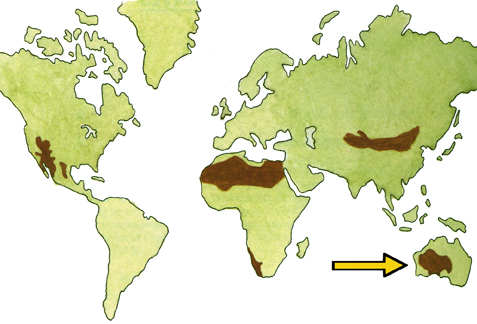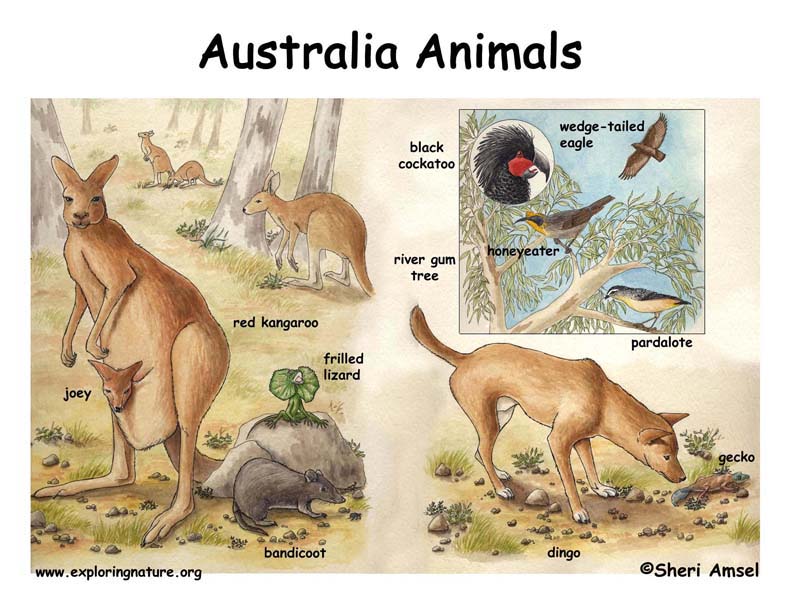

The deserts of Australia cover about one third of the whole country, roughly in the center.
Many of the Australian deserts are red sand plains with great dunes. Desert mountains, however, rise in the west like great red bluffs. The desert lying to the south is covered in stones. The desert lands here, like other deserts, have many dry lakes that shimmer from a distance as if they are full of water. This is called a “mirage” and is a reflection of the sky on the heated air just above the desert sand. Many desert travelers have been lured into the desert by mirages of water far off on the plain. It is no surprise that one of the biggest dry lakes was named Lake Disappointment.
Animals adapt to the lack of water as well. The koala, lives on the water it gets from eating the leaves of the eucalyptus tree. The pardalote, honeyeater, and black cockatoo bring color to the pale land. In the sky, the wedge-tailed eagle, Australia’s largest, soars in search of food. Looking for insects, fruits, and tender plants, the emu ranges through much of Australia from desert to grassy plains. Farmers think of them as a pest and try to kill them, but still they survive. Their great speed carries them across many miles in search of food. The young are born with cryptic stripes that make them blend in among the grasses and shrubs. Butcherbirds sing at dawn with a lovely song, but they are a ruthless hunter. When they catch prey, they kill it by stabbing it on a sharp thorn. On the ground, flocks of zebra finches hop around in search of grass seeds. Red kangaroos, travel in groups known as “mobs.” They can survive for days without water. They get the water they need from the plants they eat. When they get hot, they pant like a dog, instead of wasting water by sweating. Like most desert animals, kangaroos rest during the day in the mulga grass and graze in the cool evenings. Dingo’s, Australia’s wild dogs, travel throughout the hot plains in search of prey. Howling instead of barking, they hunt for kangaroos and other mammals. Rabbit bandicoots dig for insects underground. Geckos and lizards search the sand and rocks for eggs, insects, and small prey. The strange frilled lizard has a giant ruff around its neck and spreads it to look larger and help scare away enemies. If it doesn’t scare them, it leaps up onto its back feet and runs with all its might. Escaping predators is just as important as finding food and water.
Acacia trees survive in these arid lands by having small leaves which lose little water to the dry air. The eucalyptus leaves point up and down to catch as little direct sun as possible. River gum trees survive on the fringe of the deserts or along creek beds. These are the homes for many beautiful birds.
When you research information you must cite the reference. Citing for websites is different from citing from books, magazines and periodicals. The style of citing shown here is from the MLA Style Citations (Modern Language Association).
When citing a WEBSITE the general format is as follows.
Author Last Name, First Name(s). "Title: Subtitle of Part of Web Page, if appropriate." Title: Subtitle: Section of Page if appropriate. Sponsoring/Publishing Agency, If Given. Additional significant descriptive information. Date of Electronic Publication or other Date, such as Last Updated. Day Month Year of access < URL >.
Amsel, Sheri. "Australian Deserts" Exploring Nature Educational Resource ©2005-2024. December 16, 2024
< http://www.exploringnature.org/db/view/1701 >

